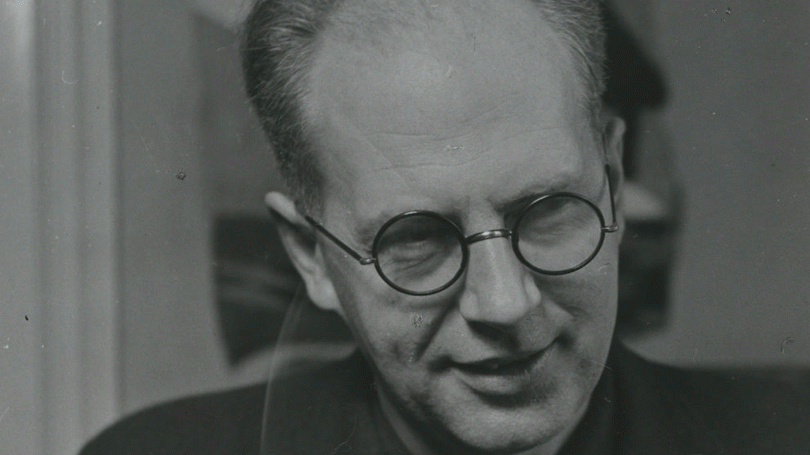Critic, writer and head of Statens Filmcentral 1946-1957, 30 March 1901 – 2 Aug. 1957.
Ebbe Neergaard, MA in German and English, was an industrious arts writer. By age 20, his poetry had been published in the periodical Klinte (1920-1921), later Hvedekorn, the primary outlet for debut writers.
Neergaard joined the Danish Monde group forming around the art pedagogue and communist avant-gardist Rudolf Broby-Johansen in 1928, though he did not regularly attend the group’s meetings. That year he obtained an associate professorship at the University of Berlin that required him to make frequent trips (including to the Soviet Union in 1930 with a pair of Monde colleagues). He stayed in Berlin until Hitler took power in 1933. The Monde group was built on the thinking of the French writer Henri Barbusse (1873-1935), particularly his writings on the Clarté organisation that emerged after World War I as an international pacifist movement professing a brand of socialism with no party affiliation. With Barbusse’s blessing, a Scandinavian version of one of his French periodicals, Monde, was started up as a monthly journal of literature, art, science, economics and politics. The Danish Monde group took over the leadership of the Studentersamfundet student society, won a majority on the Copenhagen University Council and spawned a nationwide high-school student movement.
An offshoot of Studentersamfundet, the association Forsøgsscenen ("The Experimental Stage") was formed in spring 1929 with a nine-man board, including Neergaard, the composer Knudåge Riisager and Broby-Johansen. The association published an eponymous journal until the end of 1931. In Forsøgsscenen (which also had a department for experimental theatre and puppet theatre), Neergaard was in charge of introducing and screening avant-garde films. In an article, Filmens Avantgarde (in Forsøgsscenen, No. 7, February 1930), he mentions Dreyer’s unfamiliar use of close-ups. An expanded socialist critique of experimental film is found in Neergaard’s first book on film, Hvorfor er Filmen saadan? (Why Is Film Like That?), published by Monde publications in 1931. Experimental films are criticised for lacking a sense of social reality, as they moved from pure abstraction to abstraction based on reality and culminated in social Soviet cinema. On the final page of the book he singles out Joan of Arc as
"one of the strangest and most remarkable films ever produced. It is a religious film but with no moralising sermon tone in the text, only authentic lines from the interrogation protocols, no 'miracles' or trick photography, no hazy sentimental photography, no irrelevant crowd scenes calculated only for sensation, no gorgeous, ascetic heroine – she is grey and homely, a peasant girl obsessed with an idea, pure and simple. […] In cinema it corresponds to le Corbussier’s [sic] buildings in architecture, the PH lamp in lighting technique, steel furniture in furniture art. Alongside Chaplin, Vertoff, Turin, Eisenstein, Dreyer belongs among those who understand what film is" (p. 91).
The communists, demanding active party membership, took control of Forsøgsscenen in 1931. Around the same time the monthly peridical Mondechanged its name to Plan (continuing until 1935). Since there was no longer an independent socialist party, Neergaard chose to stay with the communists, writing and co-editing Plan, while serving as a critic for Arbejderbladet, a labour paper.
Early in World War II, in 1940, Neergaard wrote the first important monograph on Dreyer, En Filminstruktørs Arbejde (Carl Th. Dreyer - The Work of a Film Director), published by the small Atheneum imprint. Neergaard’s book, which covers the films up to and including Vampyr, fuelled a new international interest in Dreyer’s work. In 1943 Neergaard had to go into exile in Sweden, where he stepped up his writing activities. Returning to Denmark after the war, he first tried to get a job at the communist newspaper Land og Folk but was flatly rejected by editor in chief Børge Houmann. Perhaps that was fortunate, for instead he became theatre and film critic for the Information newspaper, from 1945-1948. In 1946, Neergaard was honoured for his achievements in the arts and made head of Statens Filmcentral, where he remained for the rest of his life. In that position, he made sure that Joan of Arc was widely disseminated in the education sector.
In his writings, Neergaard ranged wide and far. In a lecture series, Filmkundskab (Film Appreciation) (published by Gyldendal 1950), he anticipated the film studies programme at Copenhagen University. The lectures became the basis of his history of Danish cinema, Historien om dansk film, published by Gyldendal three years after his death in 1957. Dreyer wrote the foreword:
"Yes, dear Neergaard, this time I’m writing about you. You know I’m doing so with pleasure, as a small payment on the debt I owe you."
In 1963, Ebbe Neergaard's book about Dreyer from 1940 was published in a revised edition edited by his wife Beate Neergaard and Vibeke Steinthal for the publisher Dansk Videnskabs Forlag.
Neergaard and Dreyer, and their wives, met in Berlin in 1930, while Neergaard was an associate professor at the university there and Dreyer was doing the sound post-production for Vampyr. Over the years, the two couples’ acquaintance grew. If Dreyer could even be said to have any friends, private and bashful person that he was, that distinction, too, would certainly belong to Ebbe Neergaard, Denmark’s most important film educator and Dreyer’s first biographer.
By Carl Nørrested | 23 May 2010
